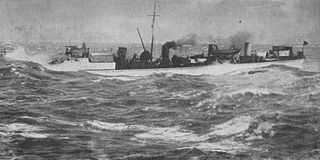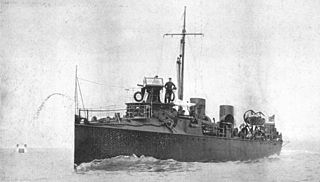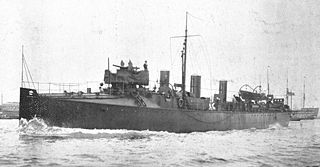HMS Thrasher was a "thirty-knotter" torpedo boat destroyer of the British Royal Navy. She was completed by Laird, Son & Company, Birkenhead, in 1897. One of four Quail-class destroyers, she served in the First World War, sinking the German submarine UC-39 in 1917, and was sold off after hostilities ended.

HMS Virago was a B-class torpedo boat destroyer of the British Royal Navy. She was completed by Laird Brothers, Birkenhead, in 1897. One of four Quail-class destroyers she served during the Great War and was sold off after hostilities ended.
HMS Wolf was a B-class torpedo boat destroyer of the British Royal Navy. She was completed by Laird, Son & Company, Birkenhead, in 1897.
HMS Seal was a B-class torpedo boat destroyer of the British Royal Navy. She was completed by Laird, Son & Company, Birkenhead, in 1897.
HMS Panther was a B-class torpedo boat destroyer of the British Royal Navy. She was completed by Laird, Son & Company, Birkenhead, in 1897.
HMS Earnest was an "thirty-knotter" torpedo boat destroyer of the British Royal Navy. She was built by Laird, Son & Company at their Birkenhead shipyard as one of six Earnest-class destroyers ordered as part of the Royal Navy's 1895–1896 construction programme, which were later classified as members of the B-class. Earnest was launched on 7 November 1896 and was completed in November 1897.
HMS Orwell was a B-class torpedo boat destroyer of the British Royal Navy. She was built by Laird, Son & Company, and served from 1900 until 1920.

HMS Bruizer was an Ardent-class destroyer which served with the Royal Navy. She was launched on 27 February 1895 by John Thornycroft at Chiswick, and was sold on 26 May 1914.

HMS Charger was a Charger-class destroyer which served with the Royal Navy. She was launched by Yarrow Shipbuilders at Poplar, London on 15 September 1894, served in home waters and was sold off in 1912.
HMS Hasty was a Charger-class destroyer which served with the Royal Navy. She was launched by Yarrow Shipbuilders in 1894, served in home waters and was sold off in 1912.

HMS Dasher was a Charger-class destroyer which served with the Royal Navy. She was built by Yarrow Shipbuilders in 1895, served in home waters and was sold in 1911.
HMS Hardy was a Hardy-class destroyer which served with the Royal Navy. She was built by William Doxford & Sons in 1895, launched on 16 December 1895, and sold off on 11 July 1911.

HMS Banshee was one of three Banshee-class destroyers which served with the Royal Navy.

Three Handy-class destroyers served with the Royal Navy. Handy, Hart and Hunter were all built by Fairfield.

HMS Handy was a Handy-class destroyer which served with the Royal Navy. Built by Fairfield Shipbuilding and Engineering Company in 1895 she spent most of her time on the China Station, and was sold in Hong Kong during the Great War.
HMS Starfish was a Sturgeon-class destroyer which served with the Royal Navy. Built by Vickers, she was launched in 1895 and sold in 1912.
HMS Skate was a Sturgeon-class destroyer which served with the Royal Navy. Built by Vickers, she was launched on 13 March 1895 and sold on 9 April 1907.

HMS Sunfish was a "twenty-seven knotter" torpedo boat destroyer of the British Royal Navy. Built by the Tyneside shipbuilder Hawthorn Leslie, Sunfish was one of three destroyers built by Hawthorns that year. She was sold for scrap in 1920.

HMS Opossum was a "twenty-seven knotter" torpedo boat destroyer of the British Royal Navy. Built by the Tyneside shipbuilder Hawthorn Leslie, Opossum was one of three destroyers built by Hawthorns that were ordered in 1894. She was launched in 1895 and completed in 1896. She remained in service during the First World War, where she was used for local patrol duties based at Plymouth and sank the German submarine UC-49 on 8 August 1918. She was sold for scrap in 1920.

HMS Ranger was a "twenty-seven knotter" torpedo boat destroyer of the British Royal Navy. Built by the Tyneside shipbuilder Hawthorn Leslie, Opossum was one of three destroyers built by Hawthorns that were ordered in 1894. She was launched in 1895 and completed in 1896. She remained in service during the First World War, where she was used for local patrol duties. She was sold for scrap in 1920.










